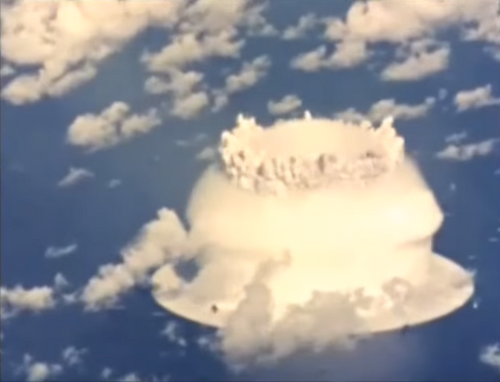Operation Albatross (Pardes)
This article is incomplete because it is pending further input from participants, or it is a work-in-progress by one author. Please comment on this article's talk page to share your input, comments and questions. Note: To contribute to this article, you may need to seek help from the author(s) of this page. |
| Operation Albatross | |||||||
|---|---|---|---|---|---|---|---|
| Part of 3rd Ostlander-Trinovantan War | |||||||
 Aerial reconnaissance image of the impact site for the M28 nuclear shell deployed during Operation Albatross | |||||||
| |||||||
| Belligerents | |||||||
|
|
| ||||||
| Commanders and leaders | |||||||
|
Admiral Douglas Anson Vice Admiral Martin Kelly | Vizeadmiral Franz Krause | ||||||
| Strength | |||||||
|
1 aircraft carrier 1 battleship 3 destroyers 2 frigates |
1 battle cruiser 2 guided missile cruisers 2 light cruisers 1 guided missile destroyer 4 destroyers | ||||||
| Casualties and losses | |||||||
|
5 aircraft destroyed 3 dead |
1 battle cruiser sunk 2 guided missile cruisers sunk 2 light cruisers sunk 1 guided missile cruiser sunk 1 destroyer beached 3 destroyers sunk 10,230 dead | ||||||
Operation Albatross was a Trinovantan naval operation that took place between July 22nd and July 24th during the 3rd Ostlander-Trinovantan War. The operation planned to lure the powerful Seestreitkräfte Kampfgruppe Krause into the open ocean and destroy it in a quick and decisive manner. This battle is particularly notable as it involves the first combat use of nuclear artillery in Pardes, which resulted in the complete destruction of Kampfgruppe Krause. The significant and lasting damage done to the ships, personnel, and local environment that occurred during Operation Albatross affected at least two international treaties: the Treatise on the Conduct of Warfare for the Civilized Nations and the Limitations on Nuclear Artillery Treaty.
Background
One of the primary goals of the Ostlichtor's Seestreitkräfte during the 3rd Ostlichtor-Trinovantum War was to disrupt trade between Trinovantum and its allies and colonies, in order to cause damage to Trinovantum's economic ability to maintain a protracted war against Ostlichtor. This was meant to be done primarily through the doctrine of "Plötzlicherschlag" (lightning attack), high-speed hit and fade raids making extensive use of signals intelligence, aerial reconnaissance and RADAR tracking to detect viable targets in conjunction with small groups of fast, well armed ships to engage and destroy the targets and their escorts. In contrast with the doctrine employed during the 2nd Ostlander-Trinovantan War, prolonged engagements with the Trinovantan Navy were to be avoided at all costs.
Initially, submarines were the principal ship type used in early Seestreitkräfte actions as they were expected to enjoy the greatest levels of success in the hit and fade tactics outlined by Ostlander naval doctrine. However, the prolific use of submarines in the 2nd Ostlander-Trinovantan War had spurred the development of new weapons and tactics to combat submarines in Trinovantum. These advancements in anti-submarine warfare made engaging even lightly defended convoys a perilous undertaking. After suffering significant losses, the Seestreitkräfte relegated its submarine forces primarily to patrol and observation duties. Other tactics were developed to work along the principals of Plötzlicherschlag. Initially the duties of the submarine fleet were given to the Seestreitkräfte's only fleet carrier, the Wolfgang Koehler, which would direct numerous air strikes against Trinovantan convoys until its destruction on October 24th, 1961 at the hands of air groups from the Trinovantan aircraft carrier Majestic.
Cumulative losses over the 4 years of war had reduced the Seestreitkräfte's ability to commit to its raiding actions significantly. By January, there were only two active raiding kampfgruppes, both of which were in need of replenishment. In late January, these two groups were combined together and bolstered by the newly converted Ritter-class guided missile cruisers. The senior-most officer of either kampfgruppe, Vizeadmiral Franz Krause, received command of this reformed kampfgruppe. Krause was already an accomplished naval commander of the 2nd Ostlander-Trinovantan War and one of the men who laid the foundation for the Seestreitkräfte's Plötzlicherschlag doctrine. With his expertise and this powerful new fleet at his disposal, he undertook an intense raiding campaign against Trinovantan forces in Mare Centralis. His fast moving and well-balanced battle fleet saw significant success over this period. Several attempts were made to eliminate Kampfgruppe Krause, using various methods such as fake radio transmissions and mock convoys to lure them into an open battle, air raids against the ports they were known to operate from, and submarine patrols along expected operating routes. However, none of these various operations saw any notable success against Kampfgruppe Krause.
On May 8th Admiral Douglas Anson, commander of the Trinovantan Navy's 2nd Fleet, formulated a plan to neutralize Kampfgruppe Krause and sent it forward to Naval High Command for approval. The document sent to high command outlined the strengths of Kampfgruppe Krause and the ways in which previous Trinovantan plans played into Krause's relative strengths. The final sections of the document then laid out a plan to destroy Kampfgruppe Krause in a single, decisive strike. This plan was approved on May 11th and preparations began on the next day.
Order of Battle
Trinovantan Forces
- Albatross Carrier Group
- Archer-class Aircraft Carrier Majestic
- Axe-class Destroyer Rook
- Dosidicus-class Frigate Hopeful
- Owens-class Frigate James Owens
- Albatross Surface Action Group
- Astoria-class Battleship Enforcer
- Daring-class Destroyer Decoy
- Daring-class Destroyer Dragon
Ostlander Forces
- Kampfgruppe Krause
- Dieterich-class Battlecruiser Prinz Dieterich
- Ritter-class Guided Missile Cruiser Ritter
- Ritter-class Guided Missile Cruiser Admiral von Alder
- Waldreich-class Light Cruiser Rietzmar
- Waldreich-class Light Cruiser Dambeck
- Glatisant-class ASW Destroyer Glatisant
- Drewen-class Destroyer Tessin
- Type 1948 Destroyer Flieden
- Type 1943 Destroyer Johann Eisen
- Type 1943 Destroyer Reiner Ganz